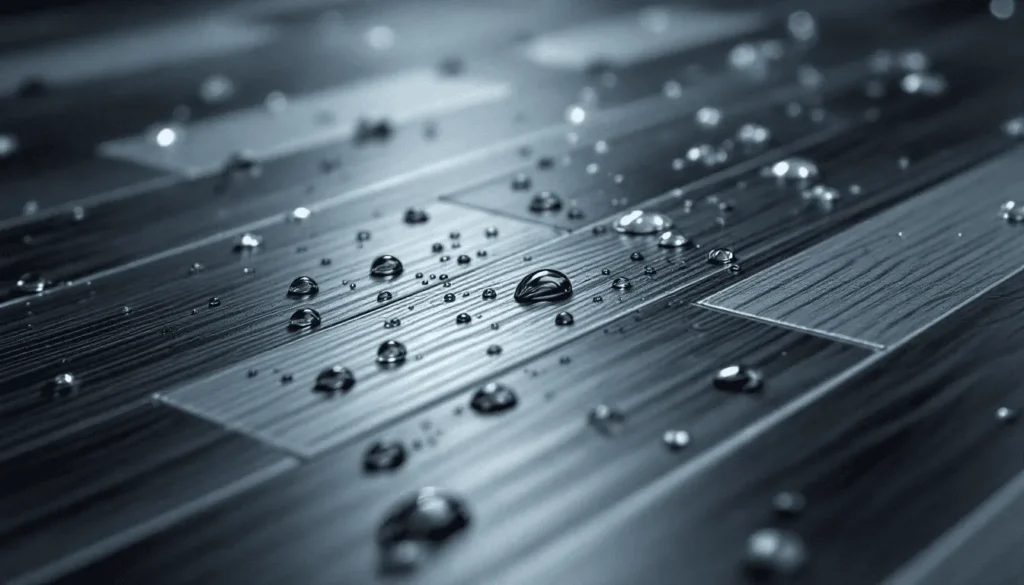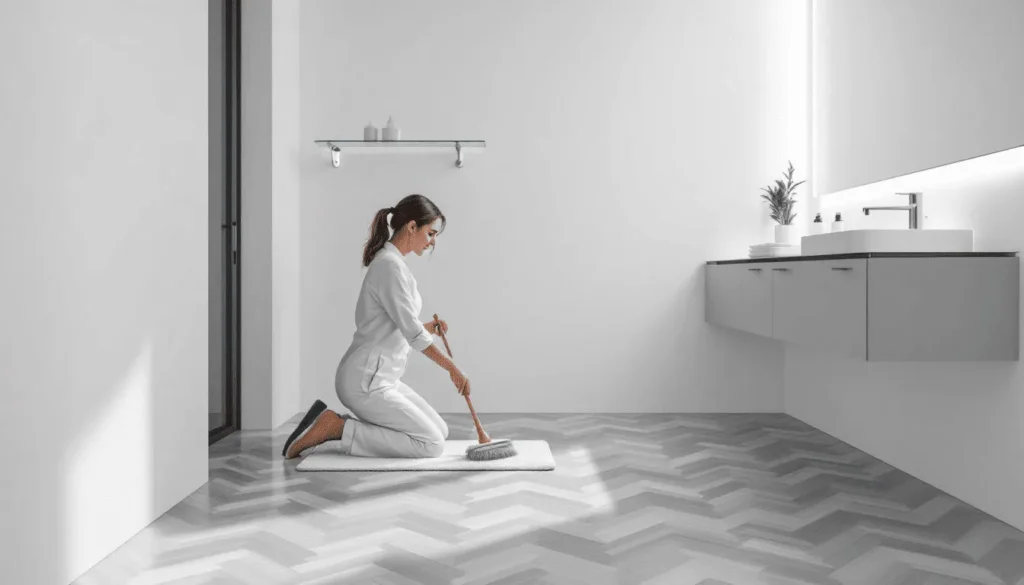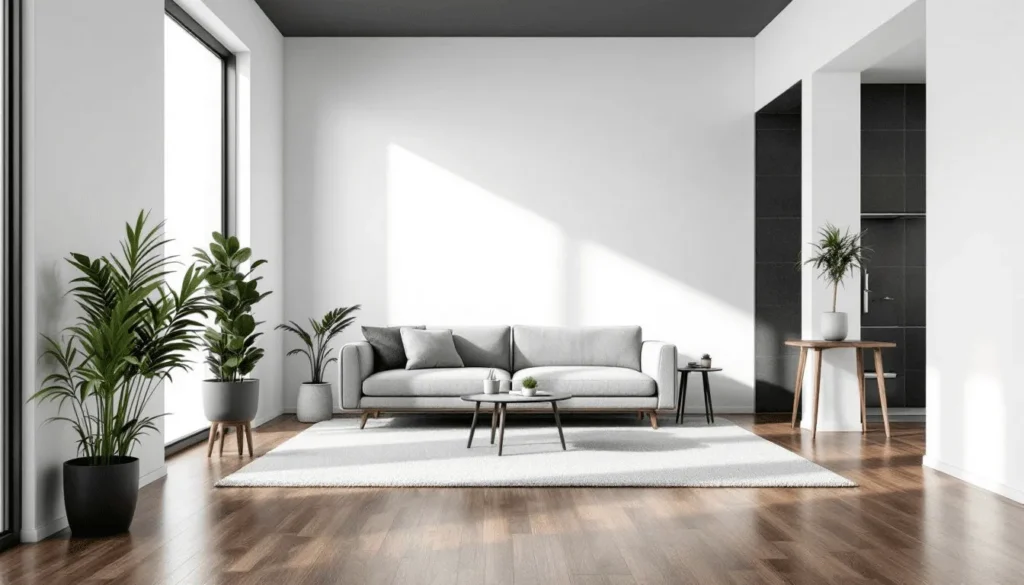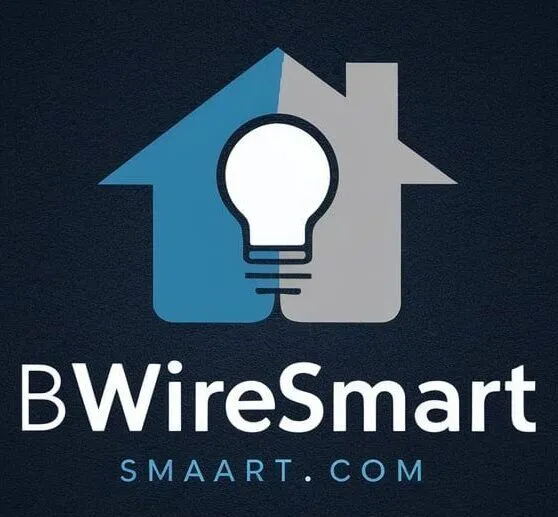Thinking about installing Vinyl Plank Flooring in Bathroom; It’s a durable and waterproof option that’s easy to install. In this article, we’ll discuss why it’s ideal for bathrooms, its key benefits, popular designs, and installation tips.
Key Takeaways
- Vinyl plank flooring is ideal for bathrooms due to its waterproof and durable properties, reducing the risk of mold and making it easy to clean.
- The installation of vinyl plank flooring is a manageable DIY project, requiring proper surface preparation and the right adhesive for long-lasting results.
- Vinyl plank offers numerous design options that mimic natural materials while being low maintenance and a budget-friendly alternative to traditional flooring materials.
Understanding Vinyl Flooring
Vinyl flooring is a versatile and popular choice for bathrooms due to its durability, water resistance, and aesthetic appeal. Available in various forms, including luxury vinyl tiles (LVT) and luxury vinyl planks (LVP), vinyl flooring is designed to mimic the look of natural materials like wood, stone, and ceramic. This makes it an excellent option for homeowners who want the beauty of these materials without the high maintenance and cost.
Luxury vinyl tiles and planks are made from synthetic materials, such as polyvinyl chloride (PVC), which gives them their impressive durability and water resistance. These flooring options are perfect for bathrooms, where moisture and humidity are constant concerns. Additionally, luxury vinyl flooring is softer and warmer underfoot compared to traditional tile floors, providing added comfort.
One of the standout features of vinyl flooring is its ability to replicate the appearance of high-end materials. Whether you prefer the classic look of hardwood floors, the elegance of natural stone, or the sleekness of ceramic tiles, there is a vinyl flooring option to match your style. This versatility, combined with its practical benefits, makes vinyl flooring a top choice for bathroom renovations.
Why Vinyl Plank Flooring is Ideal for Bathrooms

Vinyl plank flooring stands out as a top contender for bathroom renovations due to its impressive waterproof properties and ability to mimic the look of wood floors while offering better moisture resistance. Unlike traditional wood flooring, vinyl planks are highly resistant to moisture, making them an excellent choice for wet areas like bathrooms. This resistance to moisture helps reduce the risk of mold and mildew growth, ensuring a healthier environment. Additionally, vinyl bathroom flooring offers a stylish and practical solution for any bathroom design.
Beyond its waterproof nature, vinyl plank flooring is incredibly durable. It can withstand heavy foot traffic, spills, and everyday wear and tear without warping or rotting. This makes it a family-friendly option that requires minimal maintenance – often just a light sweep or a quick mop to keep it looking new. Additionally, vinyl plank floors are less slippery and warmer underfoot compared to traditional tiles, providing added comfort and safety.
Aesthetically, luxury vinyl flooring offers a perfect balance of style and durability. With a wide range of designs that mimic the look of natural materials like wood and stone, vinyl plank flooring can enhance the visual appeal of any bathroom. Its hygienic and safe properties further solidify its status as a smart choice for bathroom flooring. Additionally, lvp flooring is an excellent option for those seeking a blend of aesthetics and practicality.
Key Benefits of Vinyl Plank Floors in Wet Areas

Vinyl plank flooring is designed to thrive in high moisture conditions, making it an ideal choice for bathrooms. Its superior resistance to moisture and humidity ensures that it won’t warp or rot, even in the dampest environments. This durability guarantees that your bathroom floors will remain in excellent condition for years to come.
Safety is another crucial benefit of vinyl plank floors. Many vinyl flooring options feature slip-resistant surfaces, which can significantly reduce the risk of accidents in wet areas like bathrooms. This makes it a safer choice for households with children or elderly members.
Maintenance of vinyl plank flooring is straightforward and hassle-free. Its water-resistant properties make it easy to clean, as it resists stains and spills. A simple sweep or mop is often enough to keep the floors looking pristine, making it a practical and cost-effective solution for busy households.
Design Options with Vinyl Plank Flooring

One of the most appealing aspects of vinyl plank flooring is its ability to emulate the look of natural materials like hardwood flooring or stone while providing better durability and lower maintenance. Luxury vinyl plank flooring can mimic the aesthetic of traditional wood floors while offering practical benefits for bathrooms. Modern manufacturing techniques have made it possible to create luxury vinyl tiles that replicate the appearance of high-end flooring materials such as stone or ceramic, adding a touch of elegance to your bathroom.
The design options with vinyl plank flooring are virtually limitless. You can choose from a variety of styles, including classic oak, cherry, exotic teak, and bamboo, to match your personal style. For a contemporary edge, consider unique and abstract patterns that can add a dynamic element to your bathroom decor. Light colors are often favored in small bathrooms to enhance the perception of space, while monochrome tiles offer a sleek and unified look.
If you’re looking to create a focal point in your bathroom, patterned vinyl flooring can add character and style to an otherwise simple design. Wood-like planks can also create a warm and inviting atmosphere, perfect for a rustic farmhouse look. Whether you prefer traditional, modern, or avant-garde aesthetics, vinyl plank flooring can adapt to complement your design vision.
Pre-Installation Considerations
Before installing vinyl flooring in your bathroom, it’s essential to consider several factors to ensure a successful and long-lasting installation. Proper preparation can make a significant difference in the performance and durability of your new floors.
Assessing the Subfloor
The subfloor is the foundation of your vinyl flooring installation, and its condition is crucial for a smooth and durable finish. Start by ensuring that the subfloor is level, clean, and dry. Any imperfections, such as bumps or dips, can affect the adhesion and appearance of the vinyl flooring. Moisture issues in the subfloor can lead to problems like mold and mildew, compromising the integrity of the flooring.
If you’re unsure about the condition of your subfloor, consider hiring a professional to inspect and prepare it. They can address any issues, such as leveling the surface or installing a moisture barrier, to ensure your vinyl flooring performs optimally.
Choosing the Right Luxury Vinyl Tiles
With numerous luxury vinyl tile options available, selecting the right one for your bathroom can be overwhelming. To make the best choice, consider factors like water resistance, durability, and maintenance requirements. Look for tiles with a high wear layer and a waterproof core to ensure they can withstand the bathroom’s humid environment.
Additionally, choose tiles that complement your bathroom’s style and decor. Whether you prefer the look of natural wood, stone, or a more modern design, there are luxury vinyl tiles to match your vision. By selecting the right tiles, you can create a beautiful and functional bathroom floor that stands the test of time.
Installation Tips for Vinyl Plank Flooring
Installing vinyl plank flooring in your bathroom is a manageable DIY project that can save you time and money. Preparation is key to ensuring a successful installation, and choosing the right adhesive and proper alignment are crucial steps.
With the right tools and techniques, you can achieve a professional-looking finish that will stand the test of time.
Preparing Your Bathroom Floor
Before you start installing vinyl plank floors, it’s essential to prepare your bathroom floor properly. Ensure that the surface is clean and leveled to avoid any issues with adhesion or uneven surfaces. Thoroughly clean the floor to remove any debris, which can interfere with the installation process.
Using a moisture barrier is a crucial step in preventing moisture damage to your vinyl flooring. This layer will protect the subfloor and extend the life of your new floors.
Additionally, removing baseboards before installation can help achieve a more professional appearance and prevent uneven edges.
Choosing the Right Adhesive
Selecting an appropriate adhesive ensures the waterproof integrity of luxury vinyl plank flooring in bathrooms. A pressure-sensitive adhesive is ideal for moisture-prone areas, offering a strong bond that resists water infiltration.
Applying the adhesive correctly is essential. Follow the manufacturer’s guidelines to avoid uneven surfaces or plank damage, ensuring a smooth and long-lasting installation.
Installing Vinyl Plank Floors
Vinyl plank flooring is lighter and easier to install compared to natural stone, appealing to DIY enthusiasts. Accurate cutting of the planks ensures a perfect fit and avoids jagged edges. Tools like a utility knife and a tapping block aid in achieving precise cuts and a seamless look.
Proper alignment of click-lock planks prevents gaps or shifting over time. Caulking the edges where the flooring meets the wall prevents water from seeping underneath and causing damage.
Following these steps allows you to install vinyl plank floors confidently and achieve a professional finish.
Cost and Installation
Vinyl flooring is generally more affordable than other flooring options, such as hardwood or natural stone. However, the cost can vary depending on the quality, design, and installation method. Understanding these factors can help you make an informed decision and stay within your budget.
Cost Comparison with Other Flooring Options
When comparing the cost of vinyl flooring to other options, consider the following:
- Hardwood Flooring: Hardwood flooring is more expensive than vinyl flooring, with prices ranging from $3 to $15 per square foot. While hardwood offers a timeless and elegant look, it requires more maintenance and is not as water-resistant as vinyl, making it less suitable for bathrooms.
- Ceramic Tiles: Ceramic tiles are similar in price to vinyl flooring, with prices ranging from $1 to $10 per square foot. However, ceramic tiles require additional steps for grout and sealing, which can prolong the installation process. They also tend to be colder and harder underfoot compared to vinyl.
- Natural Stone: Natural stone flooring is typically more expensive than vinyl flooring, with prices ranging from $5 to $20 per square foot. While natural stone offers a distinct, upscale aesthetic, it requires regular sealing to maintain its appearance and prevent water damage, making it more demanding in terms of maintenance.
- Sheet Vinyl Flooring: Sheet vinyl flooring is less expensive than luxury vinyl tiles, with prices ranging from $0.50 to $2 per square foot. While sheet vinyl is a budget-friendly option, it doesn’t offer the same design flexibility or realistic appearance as luxury vinyl tiles. Additionally, if damaged, sheet vinyl may require replacing the entire sheet, whereas individual planks or tiles can be replaced more easily.
By understanding the benefits and considerations of vinyl flooring, you can make an informed decision for your bathroom renovation. Remember to assess the subfloor, choose the right luxury vinyl tiles, and consider the cost and installation factors to ensure a successful and long-lasting installation.
Maintaining Vinyl Plank Flooring in Bathrooms

Maintaining vinyl plank flooring in bathrooms is straightforward, making it practical for busy households. Regular sweeping or vacuuming removes loose dirt and debris, keeping floors clean and scratch-free. Cleaning spills immediately prevents long-term damage and staining.
Washing vinyl plank floors with a non-abrasive, no-rinse cleaner is recommended. Avoid bleach or strong solvents, as they can damage the flooring and reduce its lifespan. For scuffs, gently rub the affected area with your fingertip or apply a vinyl cleaner to restore the floor’s appearance.
Additional maintenance tips include using doormats without rubber backing to minimize dirt tracked onto the floor and closing blinds in direct sunlight to prevent fading. Use protective glides under furniture to prevent dents and scratches.
These simple maintenance practices will keep your vinyl plank flooring in excellent condition for years.
Comparing Vinyl Plank Flooring to Other Bathroom Flooring Options

Choosing bathroom flooring involves comparing different options to make an informed decision. Vinyl plank flooring offers several advantages over materials like ceramic tile, natural stone, and sheet vinyl.
The following sections compare vinyl plank flooring with these popular alternatives.
Vinyl Plank vs. Ceramic Tile
Vinyl plank flooring is generally more affordable than ceramic tiles, making it budget-friendly for bathroom renovations. Although ceramic tiles are often seen as more durable and can offer better long-term value, installing vinyl plank flooring is typically quicker and easier, requiring less time and precision.
Ceramic tiles require additional steps for grout and sealing, prolonging the installation process. Vinyl plank flooring is low-maintenance, needing only regular sweeping and occasional mopping, while ceramic tiles may need more intensive cleaning, especially of grout lines.
Vinyl Plank vs. Natural Stone
Natural stone flooring is typically more expensive than vinyl plank and offers a distinct, upscale aesthetic. However, it requires regular sealing to maintain its appearance and prevent water damage, making it more demanding in terms of maintenance.
Vinyl plank flooring is significantly more affordable and less demanding than natural stone, offering a budget-friendly and practical alternative. Its ease of maintenance and lower cost make it attractive for homeowners seeking stylish yet practical bathroom flooring.
Vinyl Plank vs. Sheet Vinyl
Vinyl plank flooring can be installed as a floating floor, allowing for quicker and easier installation compared to sheet vinyl flooring. It also offers a more authentic wood floor look and greater design flexibility with various styles and textures.
Vinyl plank flooring allows for the replacement of individual planks if damaged, whereas sheet vinyl may require replacing the entire sheet. This feature makes vinyl plank flooring more practical and versatile for bathroom renovations.
Common Mistakes to Avoid When Installing Vinyl Plank Flooring
Proper alignment is crucial when installing vinyl plank flooring to prevent gaps and enhance the floor’s overall appearance. Rushing the installation increases the likelihood of misalignment and surface imperfections, so take your time to ensure a precise fit.
Consider the weight rating of the flooring to avoid damage in areas with heavy furniture or appliances. Neglecting the manufacturer’s guidelines can lead to installation problems and may void the warranty.
Using temporary flooring protection during furniture placement prevents scratching or scuffing of the new planks. Avoiding these common mistakes ensures a successful installation and a beautiful, long-lasting floor.
Summary
In summary, vinyl plank flooring is an excellent choice for bathroom renovations due to its waterproof properties, durability, and ease of maintenance. It offers a wide range of design options that can enhance the aesthetic appeal of any bathroom while providing practical benefits like slip resistance and easy cleaning.
Whether you’re looking to update a small powder room or a large master bathroom, vinyl plank flooring is a versatile and cost-effective solution that can meet your needs. Consider this flooring option for your next bathroom renovation project and enjoy the perfect blend of style, comfort, and functionality.
Absolutely, vinyl plank flooring is perfect for bathrooms because it’s waterproof and resistant to moisture. You’ll love how it stands up to the humidity!
To keep your vinyl plank flooring in the bathroom looking its best, regularly sweep or vacuum it, clean up spills right away, and stick to non-abrasive cleaners. Just steer clear of bleach and harsh solvents!
Vinyl plank flooring is a great choice because it’s more affordable, easier to install, and requires less maintenance than ceramic tiles. Plus, it’s more comfortable underfoot and provides better slip resistance, making it a smart option for any space.
Absolutely! Vinyl plank flooring can beautifully mimic the look of natural materials like hardwood and stone, giving you a stylish and durable option for your space.
To avoid common mistakes when installing vinyl plank flooring, take your time to ensure proper alignment and follow the manufacturer’s guidelines closely. Don’t forget to use temporary protection for your floors during furniture placement to prevent any damage.
Yes, vinyl plank flooring is a great option for many homes! It’s durable, easy to maintain, and available in many styles. It’s also more affordable than hardwood or tile. However, make sure you’re choosing a high-quality product to avoid issues with wear and tear.
High-quality vinyl plank flooring is indeed waterproof, which makes it a great option for bathrooms, kitchens, and basements. However, some budget versions may not be as effective at resisting water damage, especially at the seams. Be sure to check the manufacturer’s specifications for full waterproofing details.
While vinyl plank flooring is a popular choice, there are some downsides:
Can dent easily: Heavy furniture or sharp objects can leave permanent marks or indentations.
Not eco-friendly: Most vinyl flooring is made from PVC, which isn’t biodegradable and can be difficult to recycle.
Fading and discoloration: Prolonged exposure to sunlight can cause the colors to fade.
Off-gassing: Some vinyl products may emit volatile organic compounds (VOCs), which can affect indoor air quality.
It depends on your needs:
Waterproofing: Vinyl plank is more waterproof than laminate, making it ideal for areas like bathrooms and kitchens.
Durability: Both are durable, but vinyl tends to hold up better in high-moisture areas.
Appearance: Laminate often has a harder surface and can mimic natural wood more closely, but vinyl offers a wider variety of looks and is softer underfoot.
Price: Laminate is usually cheaper than vinyl plank.


Pingback: Best Bathroom Materials for Style and Durability - Bwiresmart